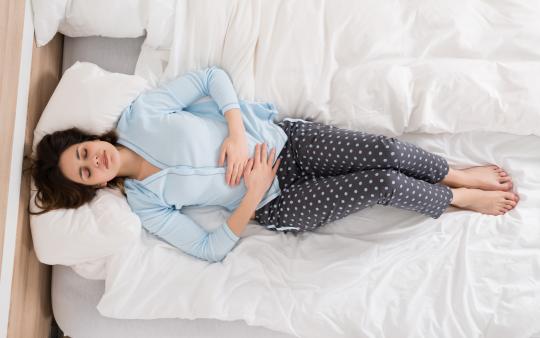It’s that time of the month, and you know what that means for you: a day or two laid out on the couch with a hot water bottle clutched to your lower abdomen, popping ibuprofen to dull the pain. This is the reality for many, with studies estimating that 50-84% of women experience menstrual pain, and at least one quarter of women require pain medication. It’s one of the top reasons for women to miss work, but common doesn’t necessarily mean normal. Periods are not meant to be painful or debilitating. Understanding the root cause of the pain and the treatment options available (beyond birth control pills and ibuprofen, which come with their own side effects and risks) can help to make period pain a thing of the past.
What Causes Period Pain?
Dysmenorrhea is the medical term for period pain that starts around the onset of your period and is achy or crampy in nature. Dysmenorrhea falls under two categories: primary and secondary dysmenorrhea. This article will focus on treatment options for primary dysmenorrhea.
Primary dysmenorrhea
This refers to pain in the lower pelvis or back that occurs on the first day or two of your period, and is related solely to your period — that is, any physical abnormalities or pelvic pathologies are absent. It typically begins in adolescence with the first period, and can persist for many years. Beyond the spasmodic painful cramping in the lower pelvis, symptoms can also include nausea, vomiting, diarrhea, fatigue, and insomnia.
Primary dysmenorrhea is generally caused by the overproduction of inflammatory cytokines (chemical messengers) called prostaglandins (PGs), which signal the uterus to contract and spasm, resulting in decreased blood flow, ischemia (low oxygen), and ultimately cramping and pain. Another piece of the puzzle is the balance of progesterone and estrogen. Women with higher estrogen levels have been shown to have a greater likelihood of primary dysmenorrhea, and it’s thought that elevated estrogen can increase production of PGs. This imbalance, which is often called “estrogen dominance,” can be accompanied by bloating, tender breasts, and PMS as well as period pain.
Secondary dysmenorrhea
Secondary dysmenorrhea is pain which can be attributed to a pelvic condition or another cause. It is typically more severe, can begin earlier in the cycle, and lasts longer than primary dysmenorrhea. Some of the conditions associated with secondary dysmenorrhea are:
- endometriosis
- uterine fibroids
- ovarian cysts
- pelvic inflammatory disease
- copper IUDs
The treatment for secondary dysmenorrhea requires identification of the underlying pathology, and treatment will differ based on the condition. Learning the facts about menstruation and the female body will be important for identifying whether a symptom is normal or needs medical attention.
Treatment Options for primary dysmenorrhea
Treating primary dysmenorrhea naturally can involve a variety of methods. These include targeting diet choices, improving circulation through exercise, and supplementing with herbs and minerals. The more positive changes you can make, the better.
Nutrition
Nutrition provides the basis of a solid treatment plan to address period pain. Eating a diet focused on whole foods including green, leafy vegetables, healthy fats, lean protein (such as fish or high-protein veggies), and whole grains provide the body with the vitamins and minerals which are essential for decreasing inflammation.
The dairy-dysmenorrhea connection:
Cow dairy contains a protein called A1 casein, which can stimulate inflammatory cytokines and result in worsening inflammation. Try removing dairy to help identify if this is one of the underlying causes of inflammation for your period pain. Other inflammatory foods to keep to avoid are trans fats and refined carbohydrates and sugars.
Exercise
It’s no surprise that exercise is high up on the treatment list! Not only does exercise improve circulation, including blood flow to pelvic muscles (remember that decreased blood flow is often a culprit in dysmenorrhea discomfort), it also releases endorphins which can moderate pain. It is also a great antidote for stress, which has been shown to be a key player in painful periods. Even when it can be difficult to find the motivation to get moving, light exercise such as going for a walk or a gentle yoga practice can be very beneficial for pain.
Herbal and Nutritional Supplements
Magnesium: Relaxes muscles (to decrease uterine spasms) and has been shown to decrease PG levels. It is one of the most important nutrients in addressing dysmenorrhea, as it targets both the root cause and symptoms, making it effective for both the prevention and acute treatment of menstrual cramps. Magnesium bisglycinate is a very absorbable form, with doses of 300mg per day (which can be increased a couple of days leading up to menses and throughout your period) showing the most beneficial outcomes.
Ginger
More typically thought of as an anti-nauseant, ginger also has potent antispasmodic actions, with higher doses shown to decrease both cramping and inflammation. The best available evidence suggests that ginger dosed at 500mg twice daily from 2 days before menses to day 3 of your period (5 days total) is the most effective in reducing period pain. In fact, one study showed ginger to be as effective as ibuprofen for pain relief in primary dysmenorrhea — and notably without the side effects!
Fish oil
The production of inflammatory prostaglandins is affected by the balance of fatty acids in the body, with omega-6s contributing to inflammation and omega-3s (found in fish oil and many “superfoods”) lowering inflammation. Several studies have shown omega-3s to be beneficial in reducing period pain; however, unlike magnesium and ginger, this is more a preventative than acute treatment, and it may take up to 3 months to see benefits.
B-vitamins
Studies have found that several of the B-vitamins are important for the treatment of dysmenorrhea. This is largely due to their action as important cofactors in the detoxification of excess estrogen (and as we know, higher estrogen levels are correlated with higher likelihood of dysmenorrhea). A large trial showed vitamin B1 taken at 100mg per day decreased even severe menstrual pain, and vitamin B6 was also found to be an effective treatment in reducing period pain. Taking a good quality B-complex may be recommended to keep a balance of B-vitamins.
Period pain doesn’t have to remain your normal! There are plenty of options that can address the pain and improve your quality of life, and get you back to living to your highest potential without resigning yourself to unnecessary discomfort. The above are general treatment options to address and reduce period pain. With any of these, it’s important to give at least 3 cycles to assess benefit and change. If pain persists beyond this point or intensifies, work with a primary healthcare practitioner to identify the root causes of your period pain and to create a treatment plan specific to you.






